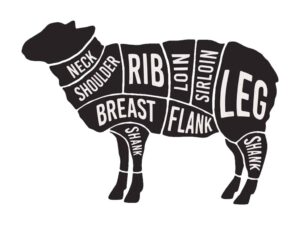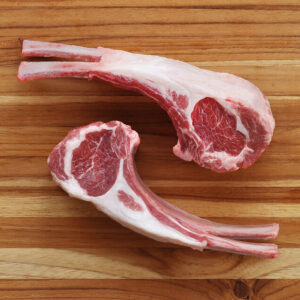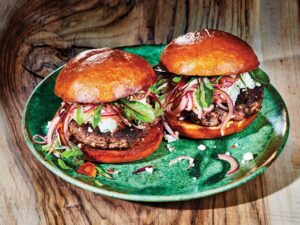Although nowhere near as popular as beef or pork in the United States, lamb is both delicious and nutritious — at least, the right lamb is. And, for those with little space to spare, buying lamb in bulk is an excellent option, as the meat from a whole lamb can easily fit inside a standard fridge freezer.
Lamb: An American underdog
Even though lamb is commonly eaten in many parts of the world, including the British Isles, Mediterranean, Middle East, and India, it’s not very popular in the United States. The average American eats just 1.1 pounds per year. Why are meat-loving Americans so uninterested in lamb?
The reason is that, quite frankly, most store-bought lamb, unless imported, isn’t particularly good. The meat often has a gamey or musty flavor that consumers, understandably, don’t enjoy. That’s because the vast majority of industrially raised lamb in the United States comes from the wrong kind of animal.
Wool sheep vs. hair sheep
 Most sheep in the United States are raised for wool; their meat is essentially a byproduct. Although you may think all breeds of sheep are basically the same, there are actually two types of sheep. Wool sheep were, as their name implies, bred over thousands of years to produce wool, which has to be sheared from the animal. More primitive hair sheep, on the other hand, have a self-shedding coat without any practical textile applications. Hair sheep are raised for their meat and milk. Wool sheep breeds produce lanolin, a greasy substance that helps lubricate their skin but also gives their meat an unpleasant taste. Hair sheep don’t produce lanolin and thus their meat has a ‘regular” flavor similar to, but lighter than, beef.
Most sheep in the United States are raised for wool; their meat is essentially a byproduct. Although you may think all breeds of sheep are basically the same, there are actually two types of sheep. Wool sheep were, as their name implies, bred over thousands of years to produce wool, which has to be sheared from the animal. More primitive hair sheep, on the other hand, have a self-shedding coat without any practical textile applications. Hair sheep are raised for their meat and milk. Wool sheep breeds produce lanolin, a greasy substance that helps lubricate their skin but also gives their meat an unpleasant taste. Hair sheep don’t produce lanolin and thus their meat has a ‘regular” flavor similar to, but lighter than, beef.
While most large agricultural operations raising sheep find it more profitable to focus on wool breeds, small-scale farms offering lamb meat or sheep’s milk products raise hair sheep. These breeds include the Black Bellied Barbados, Dorper, Dorset, Katahdin, Suffolk, Targhee, and Tunis.
What do you get when you buy in bulk?
 Lambs, usually harvested between 6 and 12 months of age, are significantly smaller than a steer or a hog. (An important note: Sheep reach sexual maturity between 4 and 6 months of age, so although we call them “lambs,” the animals we’re eating aren’t babies — they’re simply young adult sheep.) The weight of a lamb at time of slaughter is around 100 pounds. This yields about 40 pounds of packaged meat, give or take (plus several pounds of organs and soup bones). This means that the meat from even a whole lamb can comfortably fit inside a fridge freezer with room to spare. So, if you’re new to the idea of buying meat in bulk and not quite ready to take the plunge and buy a chest freezer, consider making lamb your first foray into whole-animal eating. Because of their size, lamb is usually only sold by the whole or half.
Lambs, usually harvested between 6 and 12 months of age, are significantly smaller than a steer or a hog. (An important note: Sheep reach sexual maturity between 4 and 6 months of age, so although we call them “lambs,” the animals we’re eating aren’t babies — they’re simply young adult sheep.) The weight of a lamb at time of slaughter is around 100 pounds. This yields about 40 pounds of packaged meat, give or take (plus several pounds of organs and soup bones). This means that the meat from even a whole lamb can comfortably fit inside a fridge freezer with room to spare. So, if you’re new to the idea of buying meat in bulk and not quite ready to take the plunge and buy a chest freezer, consider making lamb your first foray into whole-animal eating. Because of their size, lamb is usually only sold by the whole or half.
Like a steer or a hog, lamb can be divided into several “primals” — large sections of the animal that are then further broken down into individual retail cuts. These are the lamb primals and the retail cuts that are derived from each:
| Primal | Location | Common Cuts |
| Neck | Neck | Neck roasts |
| Shoulder | Shoulder | Shoulder roasts, shoulder chops |
| Breast | Chest | Breast roasts, spareribs |
| Rib | Top portion of sixth through twelfth pairs of ribs |
Rack of lamb, rib chops |
| Loin | Top portion of the back from the final pair of ribs to the hipbone |
Loin roasts, loin chops |
| Flank | Abdomen below loin primal | Flank roasts, flank steaks |
| Leg | Rear legs | bone-in or boneless leg roasts |
| Shank | Lower part of the leg | Shanks |
| Trim (scraps) and any unwanted portions will be ground or cut into stew meat. Lamb neck, breast, and flank primals are most commonly used for ground lamb or stew meat. | ||
When you purchase a half or whole lamb from a farmer, the butcher will ask you how you’d like your primals divided up. For instance, would you rather have bone-in leg roasts or boneless? Stew meat or ground lamb? Depending on the instructions you give, you can expect about 10 pounds of chops, 14 pounds of roasts, 2 pounds of spareribs, 4 pounds of shanks, and 10 pounds of ground lamb and/or stew meat from a whole lamb. You can also request that the butcher include bones (great for making lamb stock) and organ meats (usually the heart, liver, and kidneys). Lamb organ meats are much milder than beef or pork organs and a great point of entry for more adventurous eating.
Lamb nutrition
 While conventionally raised lamb is finished on grain, most (though not all) small-scale farms raise 100% grass-fed lamb. Grass-fed lamb is extremely nutritious. A 4-ounce serving provides 25 grams of protein, 50% of our daily niacin needs, 105% of our vitamin B12 needs, 51% of our selenium requirement, and 35% of our zinc needs, as well as respectable amounts of many other vitamins and minerals.
While conventionally raised lamb is finished on grain, most (though not all) small-scale farms raise 100% grass-fed lamb. Grass-fed lamb is extremely nutritious. A 4-ounce serving provides 25 grams of protein, 50% of our daily niacin needs, 105% of our vitamin B12 needs, 51% of our selenium requirement, and 35% of our zinc needs, as well as respectable amounts of many other vitamins and minerals.
Lamb tends to be fatty, but a large portion of that comes from monounsaturated oleic acid — the same fat that gives olive oil its reputation as a heart-healthy option. Grass-fed lamb is also high in omega-3 fatty acids. Ounce-for-ounce, it offers about 50% of the omega-3s found in cod or tuna.
Grass-fed lamb is also high in conjugated linoleic acid (CLA), a type of fat that’s been linked to improved immune function, reduced inflammation, better blood sugar regulation, and weight loss. In fact, although grass-fed beef is the poster child for CLA, grass-fed lamb contains two to three times the amount of this beneficial fat.
Cooking lamb
 Lamb is simple to cook and can be treated like grass-fed beef. Personal preferences vary, but the general consensus is that it’s best to not go past medium when it comes to lamb chops, while ground lamb (like all ground meat) should be cooked until well-done. Larger cuts, such as leg of lamb or shoulder roasts, benefit from “low and slow” cooking. Lamb doesn’t require any tenderizing or special prep in the kitchen, as grass-fed beef sometimes does.
Lamb is simple to cook and can be treated like grass-fed beef. Personal preferences vary, but the general consensus is that it’s best to not go past medium when it comes to lamb chops, while ground lamb (like all ground meat) should be cooked until well-done. Larger cuts, such as leg of lamb or shoulder roasts, benefit from “low and slow” cooking. Lamb doesn’t require any tenderizing or special prep in the kitchen, as grass-fed beef sometimes does.
Lamb offers a great chance to try cuisines from other parts of the world. Try slathering chops in a simple yet delicious British mint sauce that can be whipped up in minutes. If you’ve got a bit more time on your hands, try making an Indian lamb curry or a Moroccan lamb tagine. Or spruce up your backyard barbecues with Mediterranean-inspired lamb burgers with feta, mint, and balsamic onions.
For more information on lamb, including how much you can expect to pay and how much freezer space you’ll need, check out Appendix A of There’s a Cow in My Freezer.
